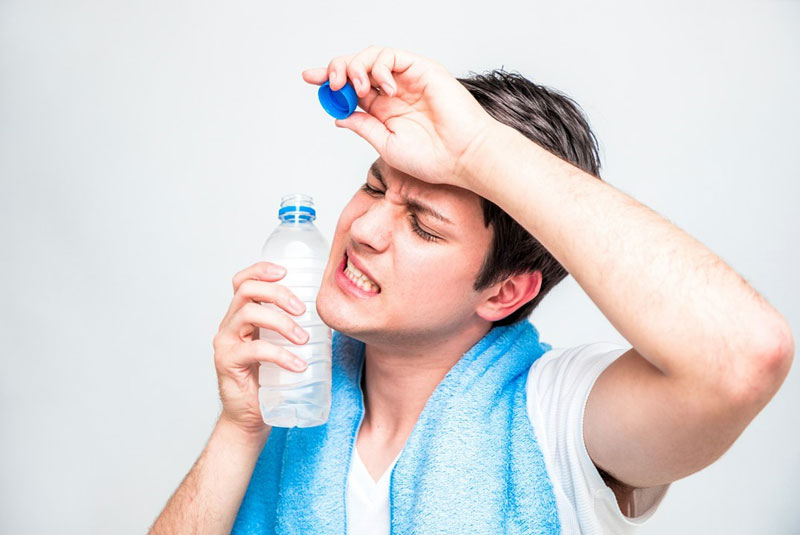Under the scorching heat of recent days, the number of patients suffering from heat stroke in hospitals has gradually increased.
Many people have only heard of heat stroke, but do not know what real heat stroke is, nor do they know how serious it is.
◆ What does heat stroke feel like?
What should I do if I have heat stroke?
Let's take a look

◆ What is heat stroke?
Heat stroke is a gradual process, which can be divided into pre-heat stroke, mild heat stroke and severe heat stroke. Patients at different stages have different symptoms. Mild ones are often accompanied by dizziness, nausea, and cramps. As the symptoms worsen, palpitations, headaches, and vomiting may occur. Severe ones have continuous muscle spasms, abdominal pain, decreased blood pressure, transient fainting, decreased judgment, delirium, drowsiness, and even coma, organ failure, so the treatment methods are also different.
01. Premonitory heatstroke
The main symptoms of premonitory heatstroke are: excessive sweating, thirst, fatigue, dizziness, or muscle cramps such as calf cramps. The body temperature is generally normal or slightly elevated (below 38 degrees Celsius), which may be accompanied by nausea and inattention. At this time, people around should immediately move the patient to a cool and ventilated place, replenish electrolyte drinks such as sports drinks, light salt water, etc., loosen the clothes, cool down with a wet towel, and avoid continuing strenuous exercise.

02. Mild heatstroke
People with mild heatstroke will have symptoms such as elevated body temperature (38-40 degrees Celsius), pale complexion, cold and wet skin, fast and weak pulse, headache, nausea, vomiting, and even transient syncope. In this case, people around should help the patient cool down quickly, such as moving him to a cool place, taking off excess clothes, wiping with cold water or applying ice packs to the neck, armpits, etc., replenishing water in time, and pay attention to drinking small amounts and multiple times when replenishing water, and avoid drinking a large amount of water at one time. If the above symptoms are not significantly relieved or aggravated, the patient may develop severe heatstroke and need emergency medical treatment.

03. Severe heatstroke
Severe heatstroke is a more serious stage of heatstroke, including three types: heat cramps, heat exhaustion and heat stroke.
- Heat cramps are more common in healthy young and middle-aged people. They are manifested as short-term, intermittent twitching of limbs or abdominal wall muscles during or after training in a high temperature environment, resulting in limited limb movement and abdominal pain, which generally lasts for several minutes. Patients often do not have a significant increase in body temperature, which may be related to the fact that they only replenish water but not salt in the case of heavy sweating, and a large amount of sodium deficiency in the body.
- Heat exhaustion is more common in the elderly, children and patients with chronic diseases, and is often manifested as excessive sweating, fatigue, weakness, dizziness, headache, decreased judgment, nausea and vomiting, muscle cramps, significantly increased heart rate, orthostatic blood pressure or transient syncope. At this time, the patient's body temperature rises, and there is no obvious neurological damage. If not diagnosed and treated in time, the patient may develop heat stroke.
- Heat stroke is the most serious type of heat stroke, and its main characteristics are increased core body temperature (>40℃) and abnormalities of the central nervous system. The main types are classic heat stroke and exertional heat stroke. Common causes involve factors such as increased heat production, excessive heat acquisition, and heat dissipation disorders. The main population of the disease is exposed to high temperature environments and people who do heavy physical labor, and the mortality rate of heat stroke is quite high. The main symptoms of heat stroke are high fever, impaired consciousness (such as delirium, convulsions, coma), and multiple organ system damage. Exertional heat stroke mainly occurs in healthy young people, often caused by heavy physical labor or strenuous exercise, and can be life-threatening. Non-exertional heat stroke mainly occurs in the elderly, weak and chronic patients, and is caused by passive exposure to hot environments.
◆ What should I do if I have heat stroke?
Keep this guide to preventing heat stroke!
01. Avoid going out during high temperature periods
The sun is strongest from 10 am to 16 pm, so everyone should stay in the shade and air-conditioned environment as much as possible. If you must go out, remember to wear sunglasses and wear light-colored, loose, breathable clothing.
02. Reasonably improve the high temperature environment
Pay attention to maintaining indoor ventilation. You can use fans and air conditioners (set at around 26°C) to avoid long-term high temperatures in confined spaces. Do not leave children or pets alone in the car. Even with the windows open, the temperature inside the car can quickly rise to over 50°C. Use sunshades when parking, and open windows for ventilation and cooling before getting in the car.

03. Scientifically adjust the intensity of activities
Avoid strenuous exercise in high temperatures, such as running and playing ball. In summer, it is advisable to choose early morning or evening to exercise. Gradually adapt to high temperatures. Outdoor workers can gradually increase the exposure time to high temperatures by 20%~30% per day.
04. Pay attention to timely hydration
Don't wait until you are thirsty to drink water. In hot weather, drink 200~300ml of water per hour. You can drink light salt water, electrolyte drinks and other heat-relief drinks. Avoid drinking alcohol, coffee, strong tea, high-sugar drinks, etc. High-sugar drinks such as cola and juice may aggravate dehydration.

%20--%3e%3c!DOCTYPE%20svg%20PUBLIC%20'-//W3C//DTD%20SVG%201.1//EN'%20'http://www.w3.org/Graphics/SVG/1.1/DTD/svg11.dtd'%3e%3csvg%20version='1.1'%20id='图层_1'%20xmlns='http://www.w3.org/2000/svg'%20xmlns:xlink='http://www.w3.org/1999/xlink'%20x='0px'%20y='0px'%20width='256px'%20height='256px'%20viewBox='0%200%20256%20256'%20enable-background='new%200%200%20256%20256'%20xml:space='preserve'%3e%3cpath%20fill='%23FFFFFF'%20d='M194.597,24.009h35.292l-77.094,88.082l90.697,119.881h-71.021l-55.607-72.668L53.229,232.01H17.92%20l82.469-94.227L13.349,24.009h72.813l50.286,66.45l58.148-66.469V24.009z%20M182.217,210.889h19.566L75.538,44.014H54.583%20L182.217,210.889z'/%3e%3c/svg%3e)




